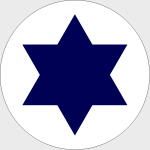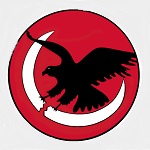Hobby Master HA1422 Israeli Defense Force McDonnell Douglas A-4H Skyhawk Attack Aircraft - No. 03, 109 Valley Squadron, Yom Kippur War, 1973 (1:72 Scale)
"The one thing I cannot forgive the Arabs for is that they forced our sons to kill their sons."
- Israeli Prime Minister Golda Meir
 The A-4 Skyhawk is an attack aircraft originally designed to operate from United States Navy aircraft carriers. Fifty years after the type's first flight, some of the nearly 3,000 Skyhawks produced remain in service with smaller air arms around the world. The aircraft was formerly the A4D Skyhawk, and was designed by the Douglas Aircraft Corporation, later McDonnell Douglas, now Boeing.
The A-4 Skyhawk is an attack aircraft originally designed to operate from United States Navy aircraft carriers. Fifty years after the type's first flight, some of the nearly 3,000 Skyhawks produced remain in service with smaller air arms around the world. The aircraft was formerly the A4D Skyhawk, and was designed by the Douglas Aircraft Corporation, later McDonnell Douglas, now Boeing.
The Skyhawk was designed by Douglas' Ed Heinemann in response to a U.S. Navy call for a jet-powered attack aircraft to replace the A-1 Skyraider. Heinemann opted for a design that would minimize size, weight, and complexity. The result was an aircraft that weighed only half of the Navy's specification and had a wing so compact that it did not need to be folded for carrier stowage. The diminutive Skyhawk soon received the nicknames "Scooter", "Bantam Bomber", "Tinker Toy Bomber", and, on account of its nimble performance, "Heinemann's Hot-Rod."
The Navy issued a contract for the type on June 12th 1952, and the first prototype first flew on June 22nd, 1954. Deliveries to Navy and U.S. Marine Corps squadrons commenced in late 1956.
The Skyhawk remained in production until 1975, with a total of 2,960 aircraft built, including 555 two-seat trainers. The US Navy began removing the aircraft from its front-line squadrons in 1967, with the last retiring in 1975. The Marines would pass on the A-7 Corsair II. The last USMC Skyhawk was delivered in 1979, and were used until the mid-1990s until they were replaced by the similarly small, but V/STOL vertical landing AV-8 Harrier.
The Israeli Air Force established the 116 Squadron in 1956 using P-51D and Mystere IVA aircraft previously operated by the 101 Squadron. The squadron was nicknamed "The Wirecutters Squadron" for its actions in the Suez Campaign which involved purposefully running through Egyptian telegraph wire in order to damage communications. Facing superior Egyptian MiGs and Meteors, the 116 Squadron lost nine P-51D Mustangs in the Suez campaign.
In 1961, the 116 Squadron had phased out the P-51D Mustang and reformed solely on the Mystere IVA, which it continued to operate for the next ten years. In 1970, the 116 Squadron began receiving A-4E Skyhawks, which it operated in the Yom Kippur War of 1973, and upgraded to the A-4N variant in 1975. In the early 1990s, the squadron upgraded to the F-16.
This particular 1:72 scale Skyhawk was flown by the Israeli Air Force's 109 Valley Squadron during the Yom Kippur War of 1973.
Sold Out!
Dimensions:
Wingspan: 4-3/4-inches
Length: 6-3/4-inches
Release Date: March 2014
 Historical Account: "War of Atonement" - The Yom Kippur War, Ramadan War or October War, also known as the 1973 Arab-Israeli War and the Fourth Arab-Israeli War, was fought from October 6th to October 26th, 1973, between Israel and a coalition of Arab states led by Egypt and Syria. The war began with a surprise joint attack by Egypt and Syria on the Jewish holiday of Yom Kippur. Egypt and Syria crossed the cease-fire lines in the Sinai and Golan Heights, respectively, which had been captured by Israel in 1967 during the Six-Day War.
Historical Account: "War of Atonement" - The Yom Kippur War, Ramadan War or October War, also known as the 1973 Arab-Israeli War and the Fourth Arab-Israeli War, was fought from October 6th to October 26th, 1973, between Israel and a coalition of Arab states led by Egypt and Syria. The war began with a surprise joint attack by Egypt and Syria on the Jewish holiday of Yom Kippur. Egypt and Syria crossed the cease-fire lines in the Sinai and Golan Heights, respectively, which had been captured by Israel in 1967 during the Six-Day War.
The Egyptians and Syrians advanced during the first 24–48 hours, after which momentum began to swing in Israel's favor. By the second week of the war, the Syrians had been pushed entirely out of the Golan Heights.
In the Sinai to the south, the Israelis struck at the "seam" between two invading Egyptian armies, crossed the Suez Canal (where the old ceasefire line had been), and cut off the Egyptian Third Army just as a United Nations cease-fire came into effect.
The war had far-reaching implications for many nations. The Arab World, which had been humiliated by the lopsided defeat of the Egyptian-Syrian-Jordanian alliance during the Six-Day War, felt psychologically vindicated by its string of victories early in the conflict, despite the end state. This vindication paved the way for the peace process that followed, as well as liberalizations such as Egypt's infitah policy. The Camp David Accords, which came soon after, led to normalized relations between Egypt and Israel -- the first time any Arab country had recognized the Israeli state. Egypt, which had already been drifting away from the Soviet Union, then left the Soviet sphere of influence entirely.


